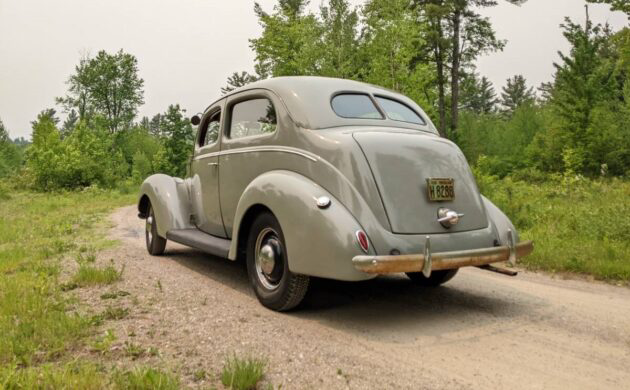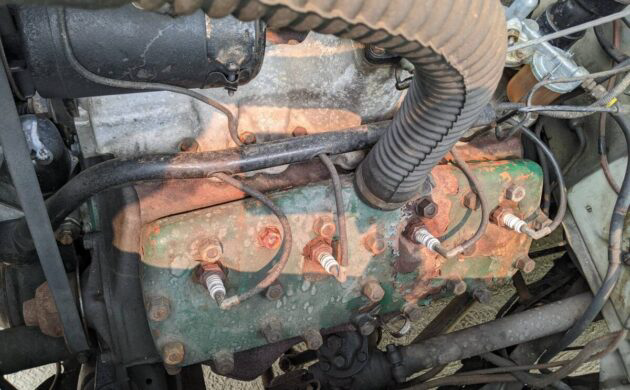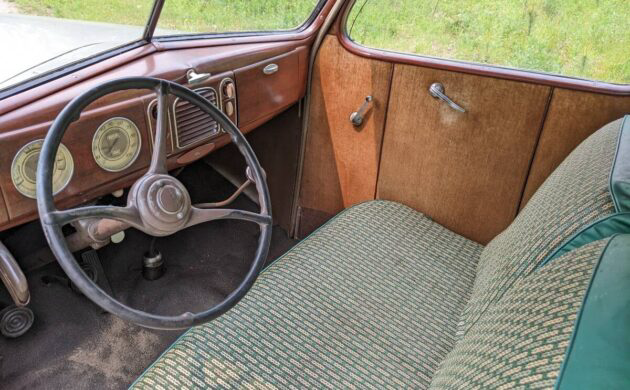After the Ford Model B in 1934, the naming/numbering system got a little confusing (at least to me). The logic had something to do with the horsepower output, yet the 85 hp flathead V8 was called the Model 78, the 60 hp version Model 74, and so forth. The 1938 models were the 81A and 82A. The seller has a Tudor for sale, a 2-door sedan that was quite popular at nearly 25% of production that year. This looks like a solid cart, yet the seller has a long list of needs for it being in storage for many years. Located in Harrisville, New York, this nice project is available here on craigslist for $10,500. Our thanks go to T.J. for this interesting tip!
Chevrolet and Ford were in hot pursuit of each other in the 1930s, taking turns having the best-selling cars in the land. When it came to propulsion, Ford had the lead with its flathead V8 available in two displacements in the latter part of the decade. Unlike prior models, the “trunkback” sedans like the seller’s car had an integrated trunk, though you could still get the traditional “flatback” body style. These Fords were available in two trim levels, standard and deluxe. Out of 410,00 cars build in 1938, the 81A was the dominant seller.
We’re told this ’38 Ford has been sitting for years, though the body and paint look decent. But the buyer is going to have to take care of the usual kinds of items when getting ready to roll again. That consists of tires. brakes, fuel system (tank and gas lines), exhaust, etc. The odometer shows just 31,000 miles, but there are no claims of this being accurate.
The interior is original and passable, so if you can get the car roadworthy, there may be no hurry to take care of the cosmetic issues, like a rusty rear bumper. The seller was planning on doing a restoration, but as is typical time and other priorities have gotten in the way.





Fix up the mechanicals, put a right taillight on it, and go have fun driving it. Nice old car.
Cool car. This imo is worth 10k VS the 18k Packard. I’d do the usual to get her roadworthy with new tires and leave it as-is.Glass packs and duals for sure.She has nice patina not a ton of surface rust like the Packard .glwts.
Nice car decent price fix it and drive it
Last year for mechanical brakes I think
Great looking as is, although ’38 was an awkward year (style-wise, standards looked like warmed-over ’37s and deluxes had a weird bird-beak hood) for Ford, and has never caught on for hot rods or restorations.. 1940 was the first year for juice brakes for Ford.
Nice looking 38. Small point, but 39 was the first year for Ford hydraulics. Many hot rodders upgraded their earlier Ford’s with 39 hydraulics. Chevy got hydraulics in 37. Plymouth had them in 29
1939 was the first year for juice brakes. Ithard to believe anyone would buy a hamper trunk over a flat back the hamper version was foul looking.
I like the fog lights with the paint color. Looks like a car Bogart would drive!
My late dad’s first car was a ’38 tudor. Brings back a lot of memories of his tales with his ol’ Ford. Bought it in high school in the early 50’s for $75. Something about always having brake issues, a hole in the passenger-side floorboard, and three different sized tires… but the smiles on his face when he would reminisce…priceless. If I had the garage space, I know where this one would be, just for Dad.
38 was a transitional year for the # of head studs. This one is a 21 stud so if the engine is original it is an early 38.
Re: the 24 stud engines, the extra 3 studs are all on the bottom row, a quick way to determine which one you have. Don’t need to count them all.
31,000 original miles? Don’t know but before President Eisenhower in the 50s created the interstate highway system, a rolled over odometer was unusual, and this ’37 lived through WW2 and gas & rubber rationing. However there was always unhooking the odometer and putting a drill on the cable and running it backwards or who can forget jacking the back end up, putting it in reverse and running the car for hours. Ha,ha. Did any of that stuff actually work? :-) Terry J
Yes, it worked!
Every time I see a ’38 Std 2-door my heart skips a beat. However, the only ones I’ve seen are bustle-backs, not slope-backs like the one I had. I sometimes miss my Std. Looking at this one, it’s definitely running 21 stud heads but those sure look like 18 mm spark plugs. 1938 was a running change. It began the year with 21 stud heads but 14 mm plugs. At the end of the season it sported 24 stud heads and the rest is history.
I see that this one has been changed to sealed beams on the front. I think you can get a kit that gives you the older appearance but very bright bulbs. If I still had my ’38 I’d look into that. Just the same you can park this at my place and I’ll give it a good home…
All Chrysler products including Plymouth and the newly acquired Dodge Brothers plus others had hydraulic brakes in 1928. Do your homework and you will find that Ford switched to hydraulic brakes in 1940. There were a lot of people installing hydraulic brakes on earlier models when thy came out in 1940.
I don’t know why this article calls this car a “B” when the the B was the four cylinder in 1932.
Actually Ford went to hydraulic brakes in ’39. Kind of under pressure because by then everyone was running hydraulics. Actually in the long run mechanical brakes were a better bet than single system juice brakes. I have a good friend who has a ’37. He broke a rear axle shaft and the wheel started making its way out. It cleared the brake shoes and if he was running hydraulics he couldn’t have stopped it. But with the mechanical brakes still functioning on the front he was able to avoid a disaster…
Yup, Henry attacked those unsafe (LOL) hydraulics. “Solid steel from pedal to wheel” was an ad I saw. :-) Terry J
Sorry, Bimmerbill, Andrew C was right – Check out the Ford sales brochures for ’39 (my birthyear) and you’ll see hydraulic brakes mentioned. I also remembered why we all went for ’40 (and later) brake conversions – the ’40s went back to the 5″ bolt-hole pattern, otherwise you were stuck with those ’36-’39 wide lug pattern wheels, never popular for hot rods (or juice brake conversions).
it don’t need a right tail lamp, it’s a ’38 for Pete sake!!!